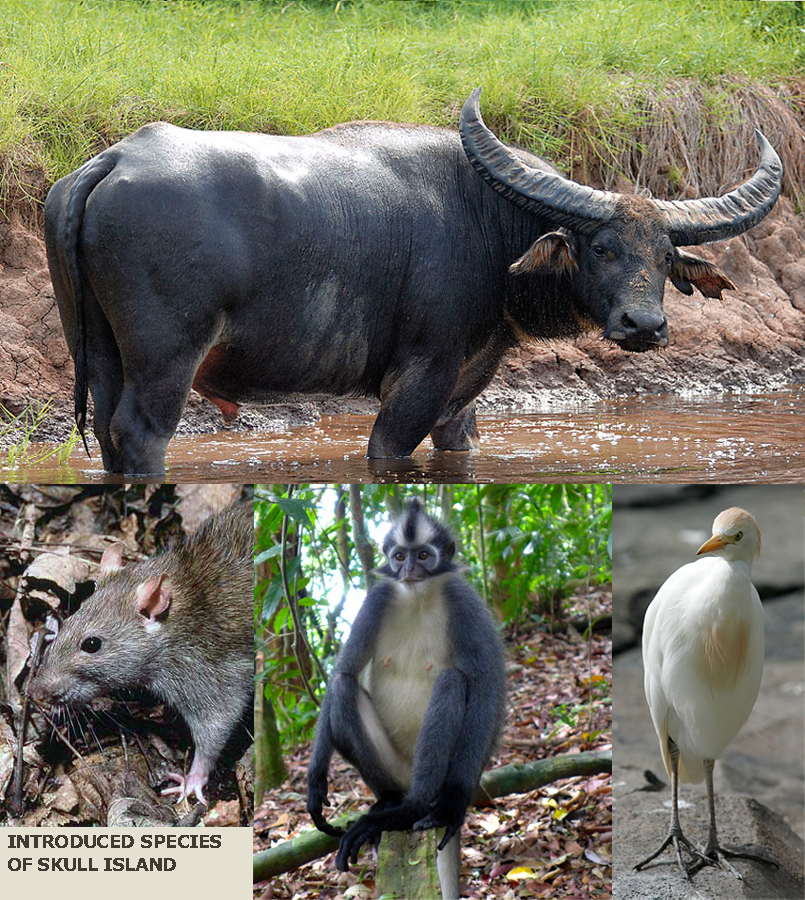ShopDreamUp AI ArtDreamUp
Deviation Actions
Description
During the course of colonization and discovery by man, Skull Island has played host to the introduction of some species from elsewhere. There are 3 main species of this nature.
The Water Buffalo (Bubalis bubalis) seems to have been introduced thousands of years ago, along with the Kongs, by the advanced megalith building society which has now vanished. These wild bovids would have been used for pulling loads or burdens, for milk and for meat. Today, they can be found mainly in the lowlands, estuaries and swamps, and the Skull Island natives will often capture individuals to use for milk or meat, but do not actively farm them.
Thomas's Langur (Presbytis thomasi) were introduced at some undetermined time before white exploration of Skull Island. The Skull Islanders may have initially brought them as pets or for meat, when they first came to live on Skull Island. These monkeys now inhabit many forested upland and lowland areas, and often provide food for more cunning predators such as Slashers. This species is implicated in an elaborate urban myth concerning the Rat Monkey, claiming that the Rat Monkey is the progeny of plague-bearing rats and Thomas's Langurs.
Brown Rats (Rattus norvegicus) were introduced at some more recent stage by white explorers or shipwrecks (as stowaways), and have since become very numerous. They are found in most terrestrial habitats and will eat almost anything nutritious, and have developed a taste for dinosaur eggs, which they gnaw at to reach the innards. Some recent researchers have expressed concern that these rat plagues may eventually endanger the dinosaur species of Skull Island.
Cattle Egret (Bubulcus ibis) are known to have only reached Skull Island within the past 2 thousand years, but appear to mostly be self-naturalized, simply flying or straying to the island in some numbers and establishing a breeding population. Notorious for following larger animals and even perching on their backs, they do so here as well, but with dinosaurs as well as the usual wild cattle. Breeding rookeries of this bird exist around some watercourses, providing a food source for smaller predators.
The Water Buffalo (Bubalis bubalis) seems to have been introduced thousands of years ago, along with the Kongs, by the advanced megalith building society which has now vanished. These wild bovids would have been used for pulling loads or burdens, for milk and for meat. Today, they can be found mainly in the lowlands, estuaries and swamps, and the Skull Island natives will often capture individuals to use for milk or meat, but do not actively farm them.
Thomas's Langur (Presbytis thomasi) were introduced at some undetermined time before white exploration of Skull Island. The Skull Islanders may have initially brought them as pets or for meat, when they first came to live on Skull Island. These monkeys now inhabit many forested upland and lowland areas, and often provide food for more cunning predators such as Slashers. This species is implicated in an elaborate urban myth concerning the Rat Monkey, claiming that the Rat Monkey is the progeny of plague-bearing rats and Thomas's Langurs.
Brown Rats (Rattus norvegicus) were introduced at some more recent stage by white explorers or shipwrecks (as stowaways), and have since become very numerous. They are found in most terrestrial habitats and will eat almost anything nutritious, and have developed a taste for dinosaur eggs, which they gnaw at to reach the innards. Some recent researchers have expressed concern that these rat plagues may eventually endanger the dinosaur species of Skull Island.
Cattle Egret (Bubulcus ibis) are known to have only reached Skull Island within the past 2 thousand years, but appear to mostly be self-naturalized, simply flying or straying to the island in some numbers and establishing a breeding population. Notorious for following larger animals and even perching on their backs, they do so here as well, but with dinosaurs as well as the usual wild cattle. Breeding rookeries of this bird exist around some watercourses, providing a food source for smaller predators.
Images used were creative commons from these locations, these links include labelling of the licences. Images have been modified into panoply.
en.wikipedia.org/wiki/Water_bu…
Image size
805x900px 846.02 KB
© 2017 - 2024 Boverisuchus
Comments10
Join the community to add your comment. Already a deviant? Log In
Nice work of introduced species. Also, did you say naturalised, as in killed of or something?



































